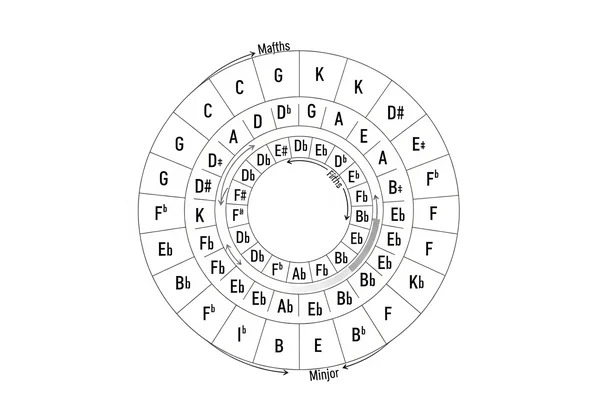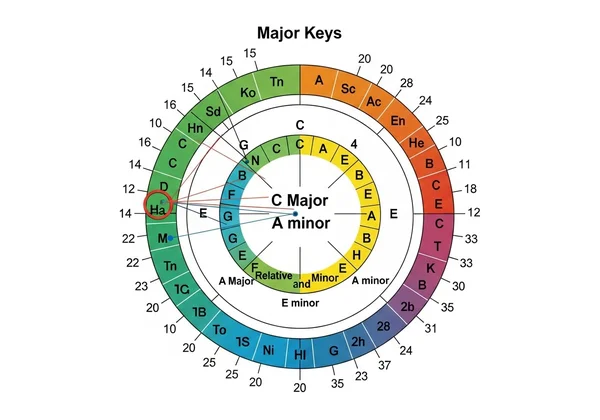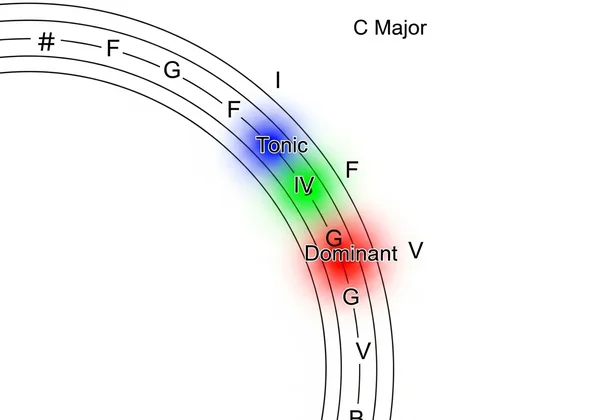The Ultimate Guide to the Circle of Fifths: Music Theory Basics
Music theory can often feel like an intimidating world of complex rules and abstract concepts. For students, songwriters, and instrumentalists, it can seem like a barrier to true creative expression. But what if there was a single, elegant diagram that could unlock it all? How can one simple tool demystify key signatures, simplify chord progressions, and revolutionize your understanding of music?
The answer lies in the circle of fifths, a powerful visual map of the relationships between the 12 tones of the chromatic scale. This guide will break down everything you need to know, from the core concepts to practical applications. More importantly, it will show you how to master this tool, and the best way to start is by exploring our interactive circle right now.

What is the Circle of Fifths and Why Does it Matter?
At its heart, the circle of fifths is a visual representation of how all 12 musical keys are related to one another. It’s a foundational concept in Western music theory that provides a roadmap for understanding harmony, melody, and composition. Think of it as a musician’s compass, always pointing you in the right direction, whether you're writing a song, improvising a solo, or just trying to understand your favorite piece of music.
Its importance is immense. It’s not just a chart to memorize; it’s a framework for thinking about music that, once understood, becomes an indispensable part of your creative process. It helps you see the "why" behind the rules, making theory practical and intuitive.
Unpacking the Concept: Definition and Core Purpose
The circle of fifths is a geometric arrangement of the 12 chromatic pitches in a sequence of perfect fifths. Moving clockwise, each key is a perfect fifth higher than the last (e.g., from C to G, G to D). Moving counter-clockwise, each key is a perfect fourth higher (or a fifth lower), like from C to F. Its core purpose is to organize and display the relationships between keys, their corresponding key signatures, and their relative minors.
Understanding its Structure: Fifths Clockwise, Fourths Counter-Clockwise
Imagine a clock face. At the 12 o'clock position, we place C Major, which has no sharps or flats. As you move one step clockwise to 1 o'clock, you arrive at G Major, a perfect fifth up from C, which has one sharp. Continue moving clockwise, and each new key adds one sharp until you reach C# Major with seven sharps.
Conversely, moving counter-clockwise from C takes you a perfect fourth up to F Major at 11 o'clock, which has one flat. Each step in this direction adds another flat, culminating in Cb Major with seven flats. This elegant structure is the key to quickly identifying any key signature, a task you can master with our online learning tool.
Major and Relative Minor Keys: Finding Their Relationship
One of the most powerful features of the circle is how it instantly shows the relationship between major and minor keys. Every major key has a "relative minor," which shares the exact same key signature. On the circle, the relative minor is always found three steps clockwise inside the major key's position. For example, C Major's relative minor is A minor (both have zero sharps or flats). G Major's relative minor is E minor (both have one sharp). This connection is fundamental for creating emotional variety in your music.

Mastering Music Theory Basics with the Circle of Fifths
The circle isn't just a theoretical diagram; it's a practical tool for mastering the fundamentals. It transforms abstract ideas into tangible, interconnected patterns, making them far easier to learn and apply.
Key Signatures Made Easy: Sharps, Flats, and Order of Accidentals
Memorizing all 12 major and minor key signatures is a common struggle for music students. The circle of fifths makes it simple. The number of sharps or flats corresponds to the key's position on the circle, counting from C. G Major is one step away, so it has one sharp. Eb Major is three steps away counter-clockwise, so it has three flats.
The circle also reveals the order of sharps (F#, C#, G#, D#, A#, E#, B#) and flats (Bb, Eb, Ab, Db, Gb, Cb, Fb). You can see this pattern emerge as you move around the circle, and our interactive chart highlights this for you instantly.
Diatonic Chords: Building Blocks of Any Key
Within any major or minor key, there is a set of seven natural, or "diatonic," chords. The circle of fifths helps you find these instantly. For any given key, the six diatonic chords are the key itself, its two neighbors on the circle, and the three relative minors of those keys. For C Major, the neighbors are F and G. Their relative minors are Dm and Em, and C's own relative minor is Am. Add the diminished chord (Bdim), and you have the complete set of chords for C Major. You can visualize chords for any key with a single click on our website.
Chord Functions: Tonic, Dominant, and Subdominant Relationships
The circle also illuminates the most important relationships in harmony: the tonic, dominant, and subdominant.
- Tonic (I): Your home base chord (e.g., C in the key of C).
- Dominant (V): The chord a perfect fifth above the tonic (G in the key of C). It creates tension and wants to resolve back home.
- Subdominant (IV): The chord a perfect fifth below the tonic (F in the key of C). It provides a feeling of moving away from home before returning.
This I-IV-V relationship is the foundation of countless songs, and the circle of fifths lays it out perfectly: your tonic is in the center, with its dominant to the right and subdominant to the left.

Learn Music Theory: Practical Applications of the Circle of Fifths
Understanding the circle is one thing; using it to create music is another. Here’s how you can apply this knowledge in practical, creative ways.
Crafting Engaging Chord Progressions: From Simple to Sophisticated
The circle is a goldmine for songwriters. Moving between adjacent keys on the circle creates smooth, pleasing chord progressions. The classic ii-V-I progression, a staple in jazz and pop, is easily found. In C Major, this would be Dm (the ii chord), G (the V chord), and C (the I chord). By exploring different patterns on the circle, you can create progressions that sound both natural and interesting.
Effortless Key Changes and Modulation Techniques
Changing keys, or modulating, can add incredible depth to a song. The smoothest modulations often occur between closely related keys—precisely the keys that are next to each other on the circle of fifths. Moving from C Major to G Major or F Major is a common and effective technique because they share so many common chords, making the transition seamless.
Composing Melodies and Improvising Solos with Confidence
When improvising or writing a melody, the circle helps you understand which notes will sound good over a given chord progression. It provides a harmonic context, guiding your note choices and helping you create lines that are both melodic and harmonically sound. It allows you to see the bigger picture, so you're not just playing random notes from a scale.
Applying the Circle to Your Instrument: Guitar, Piano, Bass, & More
The circle of fifths is universal. For guitarists, it helps map out the fretboard and understand how chord shapes relate across different keys. For pianists, it clarifies voicings and scale patterns. For bassists, it provides a powerful tool for creating walking bass lines that perfectly outline the harmony. No matter your instrument, you can practice your skills by applying these concepts directly.
Analyzing Songs: Uncover the Harmony of Your Favorite Tracks
Ever wonder why a certain song gives you chills? Use the circle of fifths to analyze its chord progression. You’ll start to see recurring patterns and recognize how composers use tonic-dominant relationships and clever modulations to build emotion. It’s like having a decoder ring for your favorite music.
Your Journey to Musical Mastery Begins Here
Forget just reading about the circle of fifths – it's time to experience it! This incredible tool is more than a diagram; it's your personal guide to unlocking music theory, from effortlessly nailing key signatures to crafting rich, beautiful harmonies. It's truly the most powerful way to connect theory to your creative flow. The best way to grasp its power is to jump in and try it. We designed our interactive tool to transform this static chart into a living, breathing resource. Stop memorizing and start understanding. Explore the interactive tool on our homepage, click on any key, hear the chords, and see the relationships come to life. Your musical journey starts now.

Frequently Asked Questions About the Circle of Fifths
How do I use the Circle of Fifths effectively in my music?
Start by using it as a reference for three key tasks: identifying key signatures quickly, finding the diatonic chords for any key, and building common chord progressions like the I-IV-V or ii-V-I. As you get more comfortable, use it to experiment with modulation to nearby keys.
What are the primary uses for the Circle of Fifths in songwriting and playing?
For songwriting, its primary use is generating chord progressions that sound harmonically pleasing and logical. For playing and improvisation, it serves as a mental map for understanding the harmonic landscape of a song, helping you make informed choices about which notes and scales to play over which chords.
What's the easiest way to memorize the Circle of Fifths for beginners?
Don't try to brute-force memorize it. Instead, understand the logic: starting from C, go up a fifth (clockwise) to add a sharp, or up a fourth (counter-clockwise) to add a flat. Use mnemonics like "Father Charles Goes Down And Ends Battle" for the order of sharps and "Battle Ends And Down Goes Charles' Father" for flats. The most effective method is daily practice with an interactive tool daily to build muscle memory.
Can the Circle of Fifths help me find the key of a song?
Absolutely. First, look at the key signature on the sheet music. The circle will tell you which major or minor key corresponds to that number of sharps or flats. If you're figuring it out by ear, listen for the "home" chord—the one that feels most resolved. Then, identify the other main chords and see where that cluster fits most neatly on the circle.